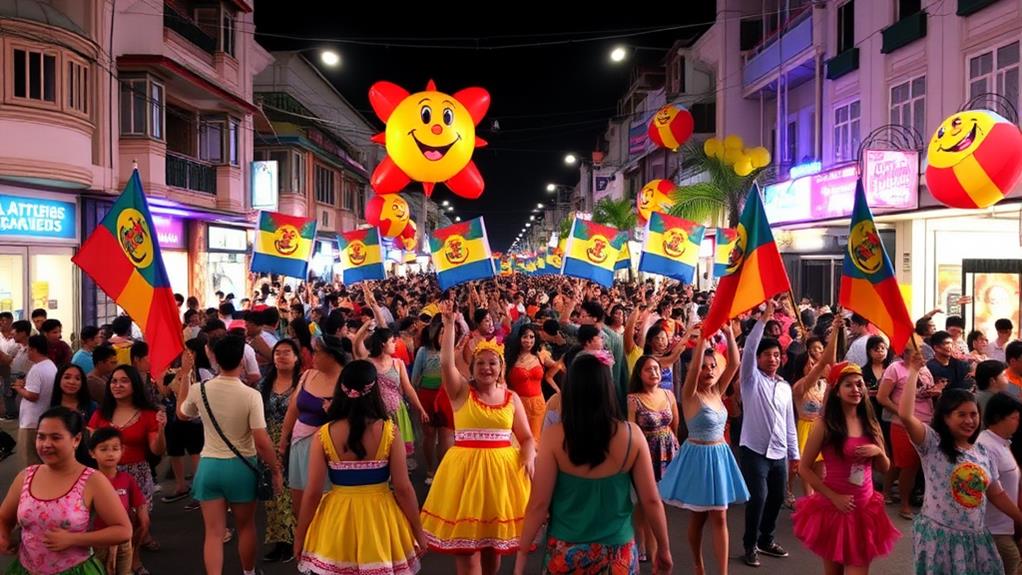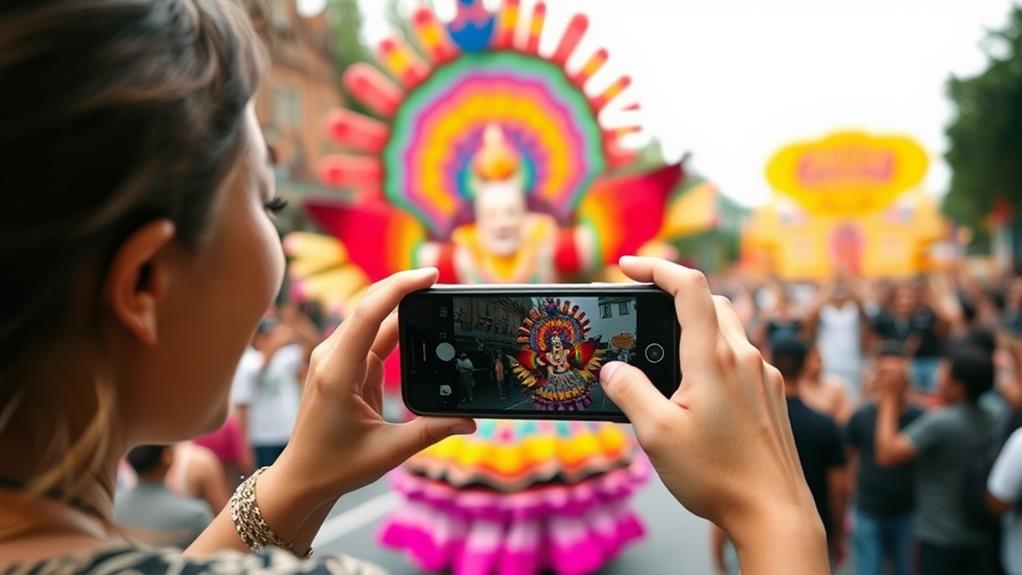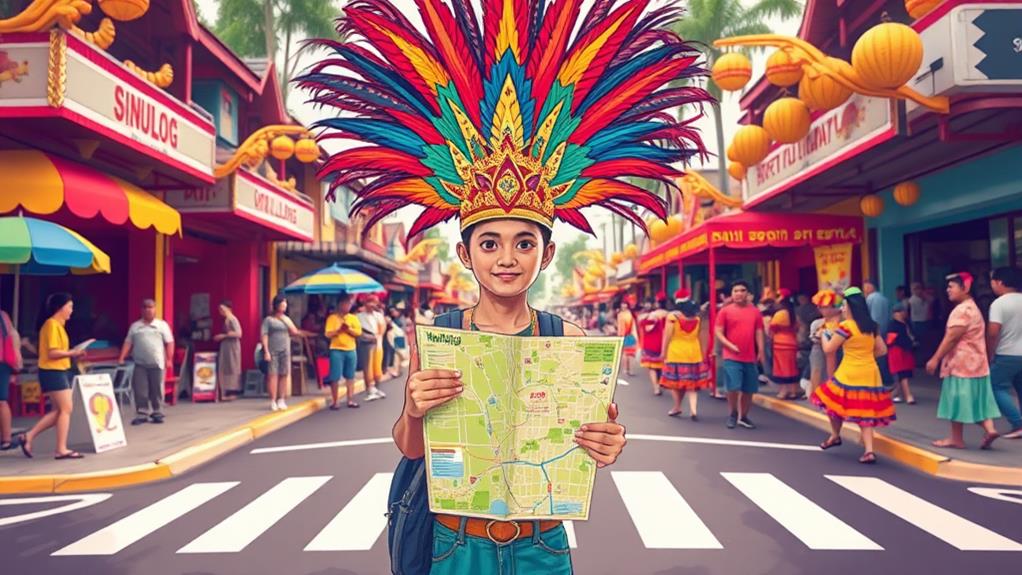To maximize your Sinulog Festival experience, immerse yourself in the rhythmic drum beats, vibrant street dancer colors, and communal joy of throwing colored powders and water-based paints.
Familiarizing yourself with the area is crucial to avoid traffic disruptions. Arrive early at key locations such as Fuente Circle for excellent Grand Parade photo opportunities. Knowing the area allows you to plan your day more efficiently and capture the best moments.
Engaging with local vendors is an essential part of the festival experience. Try traditional dishes such as Sinugba, Tinola, or Lechon to taste the local flavors. This allows you to experience the rich culture of the festival.
Exploring post-parade locations is also a great way to enjoy the festival. Visit Magellan's Cross, Basilica del Santo Niño, or Cebu Taoist Temple to experience the rich history and culture of Cebu.
Staying hydrated is vital to fully enjoy the sights, sounds, and flavors of the festival. Bring a refillable water bottle and take breaks in shaded areas to avoid dehydration.
By embracing the Sinulog spirit and following these simple techniques, you'll be on your way to an unforgettable experience.
Embracing the Sinulog Spirit

The Sinulog Festival is a vibrant celebration that showcases the rich history and culture of Cebu City.
It is one of the largest and most popular festivals in the Philippines.
The festival's spirit is characterized by rhythmic beats of drums and vibrant colors of street dancers, drawing attendees into the celebration.
The shouts of "Pit Senyor" signal the start of the festivities.
The Sinulog Festival features various street parties, where attendees throw colored powders and water-based paints, creating a kaleidoscope of colors and a sense of communal joy.
The use of colored powders and paints is a way for attendees to express themselves and celebrate the festival.
The Sinulog Grand Parade is a highlight of the festival, featuring elaborate costumes and cultural traditions that showcase the city's heritage.
The parade showcases the city's history and culture through music, dance, and costumes.
By embracing the Sinulog spirit, attendees connect with fellow festival-goers and locals, fostering a sense of community that's at the heart of this vibrant celebration.
The sense of community is a key aspect of the Sinulog Festival, bringing people together to celebrate the city's heritage.
Maximizing Your Festival Experience
Maximize Your Sinulog Festival Experience
To make the most of your time at the Sinulog Festival, plan ahead by familiarizing yourself with the area a few days before the event. This preparation will help you navigate the streets and avoid traffic disruptions caused by street closures.
Choose the Best Viewing Spot
For a relaxed viewing experience, position yourself at the Fuente Circle during the Grand Parade. This spot offers excellent photo opportunities of festival queens, street dancers, and vibrant floats.
Engage with Local Culture
Take breaks to engage with local vendors offering traditional dishes, such as lechon belly and spicy lechon sinigang. These interactions will allow you to experience the local culture and cuisine.
Explore Popular Locations
After the parade, head to popular locations like Baseline for post-parade street parties. You can also visit the Basilica Minore del Santo Niño to pay your respects and soak up the spiritual atmosphere.
Stay Safe and Hydrated
Stay hydrated by drinking lots of water, especially during key events. This simple precaution will help you fully immerse yourself in the sights, sounds, and flavors of the Sinulog Festival.
Capturing Lasting Memories

Capturing the essence of the Sinulog Festival requires a thoughtful approach to photography.
To capture the excitement and energy of the festival, arrive early at key viewing spots like Fuente Circle to photograph the colorful floats and street dancers during the Grand Parade.
Utilizing a smartphone or camera with good low-light capabilities is essential to capture the breathtaking fireworks display that concludes the parade.
Engage with festival participants by asking for posed photos, especially with beautifully dressed festival queens and dancers.
Capturing spontaneous moments of joy and camaraderie can be achieved by attending the lively street parties.
After the festival, visit historical landmarks like Magellan's Cross and the Basilica Minore del Santo Niño to document your cultural journey and create a comprehensive visual record of your Sinulog experience.
The Sinulog Festival and Flores De Mayo Festival both enhance the visitor experience through vibrant cultural performances, colorful processions, and elaborate decorations. When you visit the philippines during flores de mayo, you’ll witness the same fervor and pageantry that make the Sinulog Festival a must-see event for tourists.
Immersing in Local Culture
Immersing in Local Culture: The Sinulog Festival
The Sinulog Festival, celebrated every third Sunday of January, is a grand celebration that showcases the region's rich cultural heritage and strong faith.
A Celebration of Faith and Culture
The festival is a six-day celebration of vibrant colors and infectious rhythms that awaits you in Cebu.
As you immerse yourself in the local culture, you'll discover the significance of Pit Señor and the acceptance of Christianity in Cebu.
Historical Landmarks and Their Significance
- Basilica Minore del Santo Niño: This is the oldest Roman Catholic church in the Philippines and houses the image of the Santo Niño, a symbol of the Sinulog Festival.
- Magellan's Cross: This landmark commemorates the arrival of Spanish conquistador Ferdinand Magellan and represents the introduction of Christianity in the Philippines.
- Cebu City Heritage Monument: This monument showcases the city's rich history and cultural heritage and serves as a backdrop for street dances and festivities.
Experiencing the Festival
To experience the true spirit of the Sinulog Festival, participate in the street dances and savor local delicacies like lechon belly and spicy lechon sinigang.
Join in the street parties, where colorful powders and water-based paints add to the festive atmosphere.

Navigating the Festival Scene
The Sinulog Festival attracts hundreds of thousands of attendees, making it challenging to navigate. Arrive early to secure a good viewing spot for the Grand Parade, which starts at 9 AM.
To view the parade without the crowds, position yourself at Fuente Circle, where you can take photos of parade queens, street dancers, and floats throughout the day. This spot offers a more relaxed viewing experience.
Stay updated on the festival schedule by checking the official Facebook page or using Google Maps to navigate the area. This helps you make the most of your time at Sinulog.
When joining street parties that take place before sunset, be prepared for large crowds. Lively venues like Baseline can be particularly crowded, where you can participate in playful activities with colored powders and water-based paints.
Be mindful of the water current from the paint and water activities to stay safe.
After a fun-filled day, head to Ayala Center Cebu to unwind before going home.
Questions and Answers
What Is Your Most Memorable Experience During Sinulog Festival?
The Sinulog Festival is a significant cultural event in the Philippines. One of the most memorable experiences during the festival is dancing with newfound friends during the street party, which showcases the Filipinos' love for celebration and camaraderie. Additionally, the festival offers lechon belly, a traditional Filipino dish that is typically served during special occasions. The highlight of the festival is the Grand Parade, which features vibrant costumes that reflect the rich cultural heritage of the Philippines. These experiences make the Sinulog Festival an unforgettable celebration of cultural significance.
What Makes Sinulog Festival Unique?
The Sinulog Festival's uniqueness is rooted in its distinctive blend of history, culture, and tradition.
The festival's rich history is a key aspect of its uniqueness. It dates back to the 16th century when Spanish conquistador Miguel López de Legazpi arrived in Cebu, marking the beginning of Christianity in the Philippines. This historical event is commemorated through the festival's various activities.
The cultural significance of the Sinulog Festival also sets it apart. It is a celebration of Cebu's patron saint, the Santo Niño, which reflects the city's deep devotion to the Catholic faith. The festival showcases the blend of local traditions and Catholicism through vibrant dance performances and elaborate festival attire.
The festival's vibrant dance performances are a major highlight. These performances feature colorful costumes, lively music, and energetic dance routines that showcase the Cebuano heritage. The dancers move to the beat of drums and other percussion instruments, creating an infectious energy that draws in spectators.
The Sinulog Festival's community involvement is another distinctive aspect. The festival is a time for Cebuanos to come together and celebrate their heritage. It brings together people from all walks of life, fostering a sense of community and camaraderie. The festival's organizers and participants work together to create a memorable experience, making it a truly unique event.
What Are the Highlights and Activities of Sinulog Festival?
The Sinulog Festival showcases the city's rich history and cultural significance. This is evident through various aspects of the festival, including the attire, food, dance performances, street parties, and religious processions.
The festival attire is a vital part of the celebration. Participants wear vibrant and colorful costumes, often adorned with feathers, beads, and other decorative items. These outfits are a representation of the city's heritage and are often inspired by the traditional clothing of the region.
Traditional food offerings are another essential part of the Sinulog Festival. Various local dishes such as lechon, sinugba, and bibingka are prepared and offered to the participants and spectators. These dishes are not only delicious but also hold significant cultural value.
Captivating dance performances are a highlight of the festival. The Sinulog dance is a traditional dance that is performed by participants wearing elaborate costumes. The dance is a representation of the city's history and cultural heritage.
Lively street parties are a key aspect of the festival. These parties are held throughout the city and feature live music, dancing, and food. They are a great way for participants and spectators to come together and celebrate the festival.
Meaningful religious processions are an integral part of the Sinulog Festival. The festival culminates in a grand procession, where participants carry statues of the Child Jesus and other saints through the streets of the city. This procession is a demonstration of the city's devotion to its faith.
What Are the Forms and Practices Associated With the Sinulog?
The Sinulog festival is a celebration deeply rooted in history and culture. It showcases the cultural significance of the conversion of the native Cebuanos to Christianity. This is reflected in various dance rituals, including the traditional two-step, which symbolizes the forward and backward steps of the Sto. Niño's dance.
The traditional two-step dance ritual is a series of forward and backward steps performed to the beat of drums. This dance is a representation of the native Cebuanos embracing Christianity and their love for Sto. Niño. The ritual dance is typically performed in the streets during the Sinulog parade.
Religious practices are an essential part of the Sinulog festival. The celebration revolves around the feast day of Sto. Niño, with the main event being a grand procession. The procession features floats, marching bands, and street dancers, all paying homage to Sto. Niño.